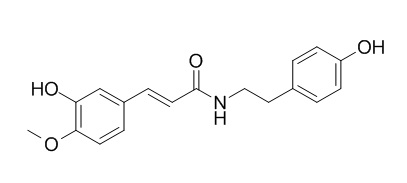Tamgermanetin
Tamgermanetin demonstrates potential cytotoxic effect against three different tumor cell lines, namely liver (Huh-7), breast (MCF-7) and prostate (PC-3).
Inquire / Order:
manager@chemfaces.com
Technical Inquiries:
service@chemfaces.com
Tel:
+86-27-84237783
Fax:
+86-27-84254680
Address:
1 Building, No. 83, CheCheng Rd., Wuhan Economic and Technological Development Zone, Wuhan, Hubei 430056, PRC
Providing storage is as stated on the product vial and the vial is kept tightly sealed, the product can be stored for up to
24 months(2-8C).
Wherever possible, you should prepare and use solutions on the same day. However, if you need to make up stock solutions in advance, we recommend that you store the solution as aliquots in tightly sealed vials at -20C. Generally, these will be useable for up to two weeks. Before use, and prior to opening the vial we recommend that you allow your product to equilibrate to room temperature for at least 1 hour.
Need more advice on solubility, usage and handling? Please email to: service@chemfaces.com
The packaging of the product may have turned upside down during transportation, resulting in the natural compounds adhering to the neck or cap of the vial. take the vial out of its packaging and gently shake to let the compounds fall to the bottom of the vial. for liquid products, centrifuge at 200-500 RPM to gather the liquid at the bottom of the vial. try to avoid loss or contamination during handling.
Nutrients2022, 14(3),695.
Foods.2021, 10(6):1378.
J Food Biochem.2019, 43(9):e12970
Molecules.2024, 29(5):1050.
Separation Science Plus2022, sscp.202200048.
Int J Mol Sci.2024, 25(1):616.
Talanta.2022, 249:123645.
Exp Biol Med (Maywood).2019, 244(18):1665-1679
Int J Mol Sci.2022, 23(13):7115.
Food Hydrocolloids2024, 156:110345
Related and Featured Products
Plant Signal Behav. 2013 Jan;8(1):e22642.
Cytotoxic isoferulic acidamide from Myricaria germanica (Tamaricaceae).[Pubmed:
23123452 ]
METHODS AND RESULTS:
Tamgermanitin, a unique N-trans-Isoferuloyltyramine, together with the hitherto unknown polyphenolics, 2,4-di-O-galloyl-(α/β)-glucopyranose and kaempferide 3,7-disulphate have been isolated from the leaf aqueous ethanol extract of the false tamarisk, Myricaria germanica DESV. In addition, 18 known phenolics were also separated and characterized. All structures were elucidated on the basis of detailed analysis of 1D- (1)H and (13)C NMR, COSY, HSQC, HMBC and HRFTESIMS spectral data. The extract, its chromatographic column fractions and the isolated isoferuloyltyramine, Tamgermanetin demonstrated potential cytotoxic effect against three different tumor cell lines, namely liver (Huh-7), breast (MCF-7) and prostate (PC-3). The IC 50''s were found to be substantially low with low-resistance possibility. DNA flow-cytometic analysis indicated that column fractions and Tamgermanetin enhanced pre-G apoptotic fraction. Both materials showed inhibiting activity against PARP enzyme activity.
CONCLUSIONS:
In conclusion, we report the isolation and identification of a novel compound, tamgermanitin, from the aqueous ethanol extract of Myricaria germanica leaves. Further, different fractions of the extract and tamgermanitin exhibit potent cytotoxic activities which warrant further investigations.
Nat Prod Res. 2016 Aug;30(16):1880-4.
Phenolic constituents from Wissadula periplocifolia (L.) C. Presl. and anti-inflammatory activity of 7,4'-di-O-methylisoscutellarein.[Pubmed:
27498833 ]
This study reports the first phenolics from Wissadula genus (Malvaceae) and the anti-inflammatory activity of 7,4'-di-O-methylisoscutellarein.
CONCLUSIONS:
Using chromatographic methods, five phenolic compounds were isolated from aerial parts of Wissadula periplocifolia (L.) C. Presl. The compounds were identified as 4-hydroxybenzoic acid, 3-hydroxybenzoic acid, trans-cinnamic acid, Tamgermanetin and 7,4'-di-O-methylisoscutellarein using spectroscopic methods.
CONCLUSIONS:
The flavone 7,4'-di-O-methylisoscutellarein showed anti-inflammatory activity by inhibiting neutrophils recruitment in a mice model of pleurisy and by decreasing significantly the production of cytokines IL-1β and TNF-α.



